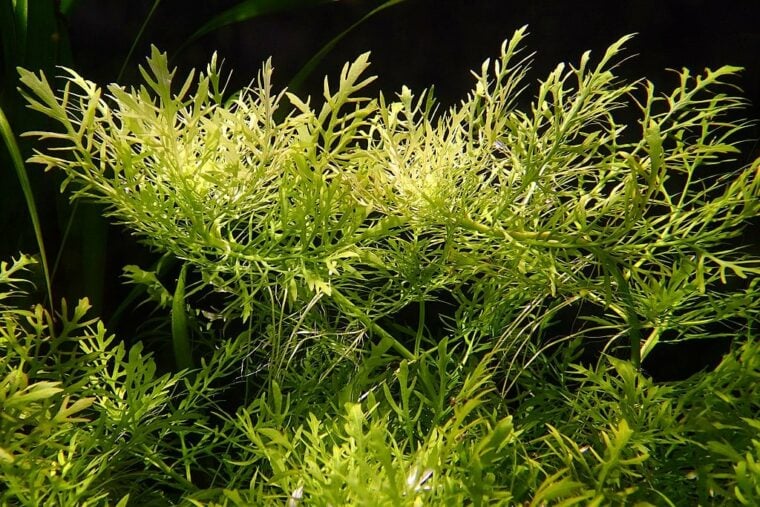
Hygrophila difformis, also known as water wisteria, is a freshwater aquatic plant that originates from the marshy habitats in Bhutan, India, Nepal, and Bangladesh and is part of the Acanthus family. Water wisteria is a very hardy and undemanding aquarium plant that can thrive in a range of water conditions. Water wisteria makes a great beginner aquarium plant. It is an easy-to-grow aquatic plant that serves many benefits and adds nice color to your aquarium. Water wisteria can be both planted or left to float at the top of the aquarium.
Useful Information About Water Wisteria
| Family Name: | Acanthaceae |
| Common Name: | Water wisteria |
| Origin: | India, Bangladesh, Bhutan, and Nepal. |
| Color: | Various shades of green |
| Size: | 20 inches in height and 10 inches in width |
| Growth Rate: | Fast |
| Care Level: | Easy; beginner-friendly |
| Lighting: | Moderate to high |
| Water Conditions: | 70–85°F, pH of 6.5–7.5, KH of 2–8 |
| Minimum Tank Size: | 10 gallons |
| Supplements: | C02, fertilizers, root tabs (optional) |
| Placement: | Floating or foreground |
| Propagation: | Cutting and replanting |
| Compatibility: | Slow growing plants |

Water Wisteria Appearance

Water wisteria has an interesting and intricate leaf display. A thin green stem develops a system of light to dark green leaves that look like little ‘swords’. The stems of the water wisteria plant are darker than the leaves and stand firm and stable. In the right conditions, water wisteria’s leaves have been known to change shape, this can help you establish whether your plant is doing well in the current water conditions your aquarium is experiencing.
The narrow protruding leaves of the water wisteria plant look quite different than many other aquatic plants. Water wisteria has the potential to grow approximately 20 inches in height and broadens out to 10 inches, making an ideal hiding place for many aquarium inhabitants. General trimming causes water wisteria to appear more bush-like and broaden much faster than if it were to be left untrimmed. Trimming your water wisteria plant should be done during a water change, as the water level will be low enough for you to reach in and trim the sides from the leaves.
Water wisteria can grow when left to float at the top of your aquarium, although do not expect it to grow to its full size. Water wisteria has a crawling benefit and will grow out along the bottom of your aquarium, sometimes even forming a lush green carpet.
Where to Find It?
Water wisteria can be found both online and in your local fish store, or even in most large chain pet stores. If you decide to buy from a pet store, it is ideal to pick the healthiest looking plant in the tank and make sure it has no pests such as snails or any leaf discoloration. When ordering online, it is best to choose a reputable source, such as Chewy or Amazon. When making an online purchase for water wisteria, keep in mind the plant may not arrive in the best condition, as shipping takes a toll on the plant. It will be expected to open the package to a limp or discolored water wisteria, although it should perk up once it is in your aquarium.

General Care
Water wisteria thrives when the aquarium’s conditions meet this plant’s requirements. Water wisteria is a hardy plant that has the potential to survive most beginner mistakes and recover successfully. Water wisteria does well with a soft to moderately hard water pH between 6.5 to 7.5 and grows well in an aquarium with a water temperature of 70–85°F and leans towards being more of a tropical aquarium plant.
The water wisteria plant does not require growth supplements such as C02 injects, fertilizers, or root tabs, but they do grow and thrive better when supplements are occasionally added. If you want to grow your water wisteria to its full potential, regular trimming can be done as well as using good quality fertilizers such as API Leaf Zone plant fertilizer found on Chewy, or the Aqueon plant food. To keep your water wisteria healthy, it is best to maintain water wisteria in soft to moderately hard water, tropical temperatures, and good water quality with oxygen added in the form of an air stone, bubbler, or spray bar to the aquarium.

Habitat, Tank Conditions & Setup

Aquarium/tank size
Water wisteria can grow quite large in most home aquariums, both in height and width. A minimum tank size of 10 gallons is appropriate to support the fast growth of the water wisteria plant.
Water temperature & pH
Water wisteria thrives with a water temperature of 70–85°F (or 21–30°C) in tropical heated aquariums. The water wisteria’s preferred pH level is anywhere between 6.5 to 7.5, which is soft to moderately hard water, although they do better in soft water.
Substrate
Water wisteria can be both planted or left to float at the top of your aquarium. An ideal substrate of fine gravel or aquarium sand filled up in the aquarium to about 2 inches to allow appropriate rooting to occur.
Plants
Water wisteria can grow well along with slow-growing plants that do not bush out and intertwine with the leaves of the water wisteria. If you choose to float your water wisteria, bushy plants can be grown alongside water wisteria in the foreground of your aquarium, keep in mind floating water wisteria can block out essential light aquarium plants require, low light for growing plants will work best with floating water wisteria.
Lighting
Water wisteria does well under moderate to high lighting, whether natural lighting from a window or under artificial lighting. They do not receive enough light to thrive if other aquatic plants dominate the tank. Water wisteria should have at least 7 hours of moderate lighting to properly grow and remain healthy.
Filtration
Water wisteria makes an excellent plant for plant-filtered tanks. Water wisteria uses ammonia, nitrites, and nitrates (all three in high levels are harmful to your aquarium inhabitants) from your aquarium to grow.

Planting Tips
When planting water wisteria, make sure you use an aquarium sand substrate or fine gravel of roughly 2 inches to encourage proper rooting. One problem most aquarists come across when planting aquatic plants is uprooting, whether it be by a fish such as a goldfish who is well known to take the opportunity to dig up your plant, or if the substrate is not deep or heavy enough to hold down the plant.
A solution to these problems is to use an aquarium ornament to weigh down your water wisteria. You can also use specific aquatic plant weights to hold the roots down and avoid your water wisteria from being uprooted.
If you are looking for a more aesthetically pleasing solution, using decent-sized pebbled lined around the plant can work as well. Before planting water wisteria, you can place root tabs or add fertilizers to the substrate to speed up the rooting process.
The Benefits of Having Water Wisteria in Your Aquarium
Concerns About Water Wisteria
The water wisteria plant does have some concerns, although the benefits greatly outweigh the concerns. Water wisteria grows quite fast in the right conditions, which can pose trouble and quickly overrun an aquarium and regular trimming can keep this under control. Water wisteria can block out essential light your other aquatic plants may require due to the structure water wisteria grows in, both vertically and horizontally.
Although water wisteria produces oxygen for your aquarium in the light periods, when nightfall water wisteria will take out oxygen in the water, this can be harmful if you do not have adequate surface agitation and aeration throughout the aquarium. Water wisteria uses a lot of nutrients in the water to grow, which puts it in competition with the other aquatic plants. The bigger the plant grows, the more nutrients it will absorb from the water, so make sure you can provide occasional supplements.

Conclusion
The water wisteria plant makes an excellent and appealing aquatic plant for many aquariums. Water wisteria is low maintenance and quite undemanding which is why it is regarded as a great novice aquatic plant. The benefits of water wisteria are exceptionally intriguing, and the stunning leaf structure adds a unique look to most aquariums. Water wisteria grows well amongst most aquatic plants and keeps your aquarium’s water in good condition by removing harmful toxins, as well as providing benefits to your aquarium inhabitants. If your aquarium meets the requirements to house the water wisteria plant, then water wisteria will make a great addition to your aquarium!
Featured Image Credit: Hygrophila difformis (Image Credit: Krzysztof Ziarnek, Kenraiz, Wikimedia Commons CC BY-SA 4.0 International)









